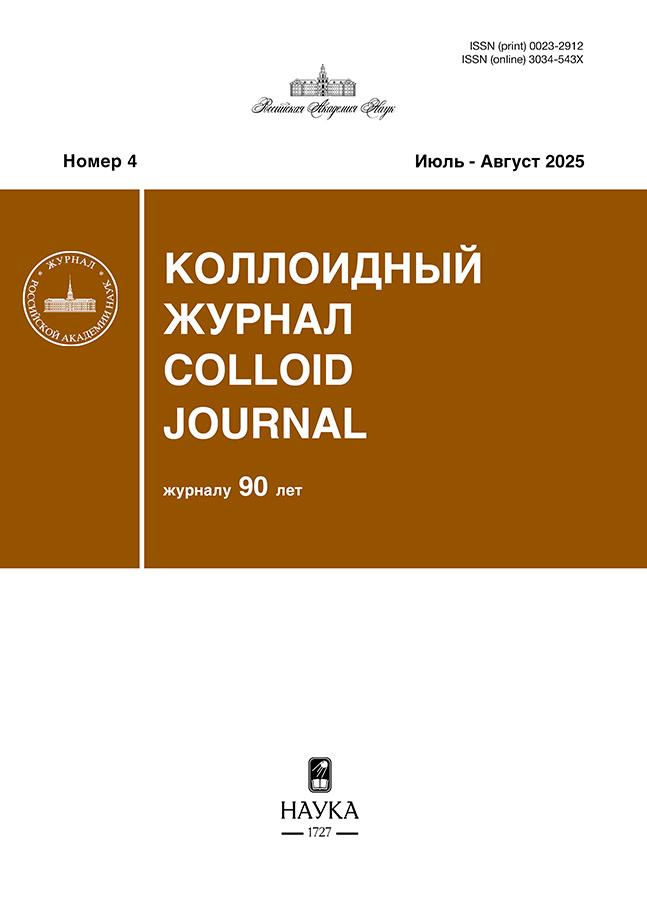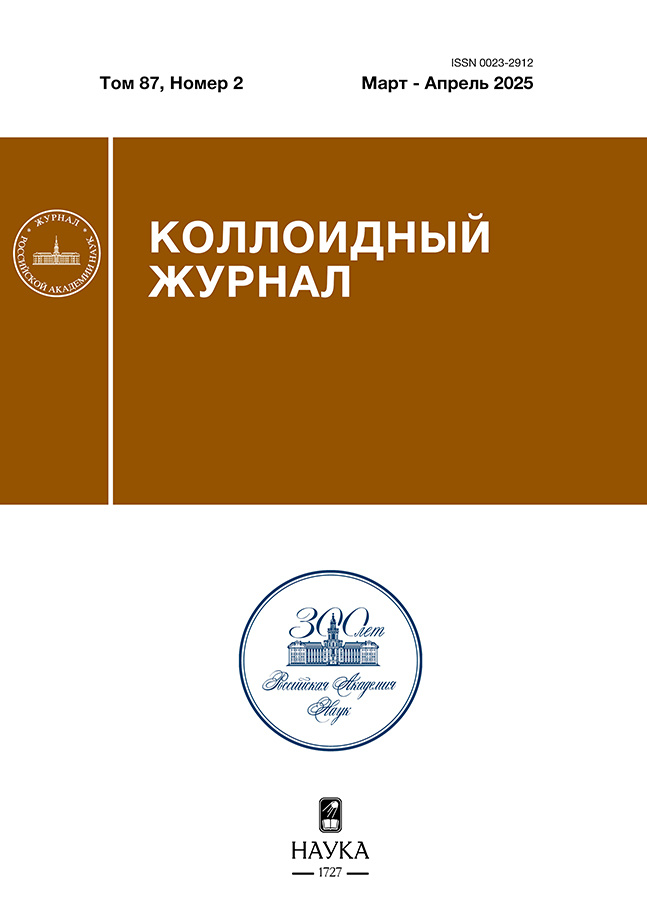О расчете электрокинетического потенциала частиц в дисперсиях детонационного наноалмаза
- Авторы: Ермакова Л.Э.1, Чуйков Н.С.1, Волкова А.В.1
-
Учреждения:
- Санкт-Петербургский государственный университет
- Выпуск: Том 87, № 2 (2025)
- Страницы: 118-127
- Раздел: Статьи
- Статья получена: 06.07.2025
- Статья одобрена: 06.07.2025
- Статья опубликована: 04.09.2025
- URL: https://rjpbr.com/0023-2912/article/view/686796
- DOI: https://doi.org/10.31857/S0023291225020043
- EDN: https://elibrary.ru/tpcxzl
- ID: 686796
Цитировать
Полный текст
Аннотация
Проведена оценка применимости различных приближений теории электрофореза для расчета электрокинетического потенциала в реальных нанодисперсных системах на примере полидисперсного водного золя термоокисленного детонационного наноалмаза, содержащего агрегаты наночастиц, в зависимости от концентрации и рН растворов фонового электролита (NaCl). Установлено, что при малых величинах потенциалов |ζW| < 25 мВ, найденных для первичных частиц в рамках модели Вирсемы, учет агрегирования частиц и пористости агрегатов практически не сказывается на величине электрокинетического потенциала. В интервале значений | ζW| 25–50 мВ наиболее достоверные величины электрокинетических потенциалов агрегатов, по-видимому, могут быть получены с использованием уравнения Миллера для ионопроводящих частиц с учетом их реальных пористостей при условии постоянства потенциала. При |ζW| > 50 мВ, зная реальные размеры агрегатов, в предположении их монолитности для расчета электрокинетических потенциалов можно использовать уравнение Овербека с найденными Ошимой аналитическими выражениями входящих в него функций f3(κr) и f4(κr).
Полный текст
Об авторах
Л. Э. Ермакова
Санкт-Петербургский государственный университет
Email: anna.volkova@spbu.ru
Россия, Санкт-Петербург
Н. С. Чуйков
Санкт-Петербургский государственный университет
Email: anna.volkova@spbu.ru
Россия, Санкт-Петербург
А. В. Волкова
Санкт-Петербургский государственный университет
Автор, ответственный за переписку.
Email: anna.volkova@spbu.ruро
Россия, Санкт-Петербург
Список литературы
- Xu J., Chow E. Biomedical applications of nanodiamonds: From drug-delivery to diagnostics // SLAS Technology. 2023. V. 28. № 4. P. 214–222. https://doi.org/10.1016/j.slast.2023.03.007
- Wang X., Sang D., Zou L. et al. Multiple bioimaging applications based on the excellent properties of nanodiamond: A Review // Molecules. 2023. V. 28. P. 4063. https://doi.org/10.3390/molecules28104063
- Turcheniuk K., Mochalin V.N. Biomedical applications of nanodiamond // Nanotechnology. 2017. V. 28. P. 252001–252027. https://doi.org/10.1088/1361-6528/aa6ae4
- Pan F., Khan M., Ragab A.H. et al. Recent advances in the structure and biomedical applications of nanodiamonds and their future perspectives // Materials & Design. 2023. V. 233. P. 112179. https://doi.org/10.1016/j.matdes.2023.112179
- Kryshtal A.P., Mchedlov-Petrossyan N.O, Laguta A.N. et al. Primary detonation nanodiamond particles: Their core-shell structure and the behavior in organo-hydrosols // Colloids and Surfaces A: Physicochemical and Engineering Aspects. 2021. V. 614. P. 126079. https://doi.org/10.1016/j.colsurfa.2020.126079
- Mchedlov-Petrossyan N.O., Kriklya N.N., Kryshtal A.P. et al. The interaction of the colloidal species in hydrosols of nanodiamond with inorganic and organic electrolytes // Journal of Molecular Liquids. 2019. V. 283. P. 849–859. https://doi.org/10.1016/j.molliq.2019.03.095
- Mchedlov-Petrossyan N.O., Kriklya N.N., Laguta A.N., Osawa E. Stability of detonation nanodiamond colloid with respect to inorganic electrolytes and anionic surfactants and solvation of the particles surface in DMSO–H2O organo-hydrosols // Liquids. 2022. V. 2. P. 196–209. https://doi.org/10.3390/liquids2030013
- Kulvelis Yu.V., Shvidchenko A.V., Aleksenskii A.E. Stabilization of detonation nanodiamonds hydrosol in physiological media with poly(vinylpyrrolidone) // Diamond and Related Materials. 2018. V. 87. P. 78–89. https://doi.org/10.1016/j.diamond.2018.05.012
- Соболева О.А. Устойчивость гидрозолей детонационных наноалмазов в присутствии солей и поверхностно-активных веществ // Коллоидный журнал. 2018. Т. 80. № 3. С. 338–343. https://doi.org/10.7868/S0023291218030114
- Сычёв Д.Ю., Жуков А.Н., Голикова Е.В., Суходолов Н.Г. Влияние простых электролитов на коагуляцию гидрозолей монодисперсного отрицательно заряженного детонационного наноалмаза // Коллоидный журнал. 2017. Т. 79. № 6. С. 785–791. https://doi.org/10.7868/S0023291217060118
- Gareeva F., Petrova N., Shenderova O., Zhukov A. Electrokinetic properties of detonation nanodiamond aggregates in aqueous KCl solutions // Colloids and Surfaces A: Physicochemical and Engineering Aspects. 2014. V. 440. P. 202–207. https://doi.org/10.1016/j.colsurfa.2012.08.055
- Petrova N., Zhukov A., Gareeva F. et al. Interpretation of electrokinetic measurements of nanodiamond particles // Diamond & Related Materials. 2012. V. 30. P. 62–69. https://doi.org/10.1016/j.diamond.2012.10.004
- Жуков А.Н., Гареева Ф.Р., Алексенский А.Е. Комплексное исследование электроповерхностных свойств агломератов детонационного наноалмаза в водных растворах КСl // Коллоидный журнал. 2012. Т. 74. № 4. C. 483–491.
- Швидченко А.В., Дидейкин А.Т., Жуков А.Н. Конденсация противоионов в гидрозолях монокристаллических частиц детонационного наноалмаза, полученных отжигом агломератов в атмосфере воздуха // Коллоидный журнал. 2017. Т. 79. № 4. С. 521–524. https://doi.org/10.7868/S0023291217040140
- Патент RU2599665C2, 15.10.2013.
- Волкова А.В., Белобородов А.А., Водолажский В.А. и др. Влияние рН и концентрации индифферентного электролита на агрегативную устойчивость водного золя детонационного алмаза // Коллоидный журнал. 2024. Т. 86. № 2. С. 169–192. https://doi.org/10.31857/S0023291224020031
- Lyklema J. Fundamental of Interface and Colloid Science V. 2. Solid-Liquid Interfaces. London: Academic Press. 1995.
- Ohshima H. A simple expression for Henry’s function for the retardation effect in electrophoresis of spherical colloidal particles // Journal of Colloid and Interface Science. 1994. V. 168. P. 269–271. https://doi.org/10.1006/jcis.1994.1419
- Wiersema P.H., Loeb A.L., Overbeek J.Th.G. Calculation of the electrophoretic mobility of a spherical colloid particle // Journal of Colloid and Interface Science. 1966. V. 22. P. 78–99. https://doi.org/10.1016/0021-9797(66)90069-5
- Overbeek J.T.G. Theorie der Elektrophorese // Fortschrittsberichte über Kolloide und Polymere. Kolloid-Beihefte. 1943. V. 54. № 7–9. P. 287– 364. https://doi.org/10.1007/bf02556774
- Ohshima H. Approximate analytic expression for the electrophoretic mobility of a spherical colloidal particle // Journal of Colloid and Interface Science. 2001. V. 239. P. 587–590. https://doi.org/10.1006/jcis.2001.7608
- Levine S., Neale G.H. The prediction of electrokinetic phenomena within multiparticle systems. I. Electrophoresis and electroosmosis // Journal of Colloid and Interface Science. 1974. V. 47. № 2. P. 520–529. https://doi.org/10.1016/0021-9797(74)90284-7
- Miller N.P., Berg J.C., O’Brien R.W. The electrophoretic mobility of a porous aggregate // Journal of Colloid and Interface Science. 1992. V. 153. № 1. P. 237–243. https://doi.org/10.1016/0021-9797(92)90315-D
- Neale G.H., Nader W.K. Prediction of transport processes within porous media: Diffusive flow processes within an homogeneous swarm of spherical particles // AIChE Journal. 1973. V. 19. P. 112–119. https://doi.org/10.1002/aic.690190116
Дополнительные файлы




















